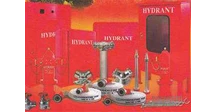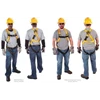- Harnesses & Lanyards, Body Belts, Harnesses, and Lanyards, Full-Body Harnesses.
Harnesses & Lanyards, Body Belts, Harnesses, and Lanyards, Full-Body Harnesses.
Update Terakhir
01 / 12 / 2019
Min. Pembelian
0 Unit
Harga
CALLBagikan
ABADI UTAMA GLODOK Kami Menjual Fire Protection Engineering, Safety Equipment Center, Multimeter, Engineering Plastik, Heater, Industrial Materials dan General Trading yang berkualitas bagus dan harga murah / bersaing / terjangkau.
Detail Harnesses & Lanyards, Body Belts, Harnesses, And Lanyards, Full-Body Harnesses.
What should you know about fall protection? If you are at risk for falling three meters or more at your workplace, you should wear the appropriate fall protection equipment. If fall protection is required, establish a complete fall protection program if one is not in place. The program should include training workers, selecting, fitting, and inspecting the equipment. What should you know about fall protective equipment? Inspect your equipment before each use. Replace defective equipment. If there is any doubt about the safety of the equipment, do not use it and refer questionable defects to your supervisor. Replace any equipment, including ropes, involved in a fall. Refer any questionable defects to your supervisor or check with the manufacturer. Every piece of fall arrest equipment should be inspected and certified at least yearly or more often by a trained and competent person. Keep written records of inspections and approvals. It is advisable to use energy absorbers if the arresting forces of the lanyard alone can cause injury. Follow the manufacturer’ s instructions about: the purpose of the device, hazard warnings, instructions and limitations on use, the stretch distance of the harness, instructions for fitting and adjusting, recommendations for care ( cleaning, maintenance, and storage) and inspection, the purpose and function of the fall arrest indicator, a warning if a fall occurs or inspection reveals an unsafe condition that the device be taken out of service until it has been determined safe for use or destroyed, and instructions for proper application, use, and connecting to full body harness of any evacuation device. Use the right equipment for the job. Refer to the series of Canadian Standards Association ( CSA) Standards Z259, including: Z259.1-05 ( R2010) " Body belts and saddles for work positioning and travel restraint" , Z259.2.3-12 " Descent devices" , Z259.10-12 " Full Body Harnesses" , Z259.11-05 ( R2010) " Energy absorbers and lanyards" , Z259.12-01 ( R2011) " Connecting components for personal fall arrest systems ( PFAS) " , and any other standards or legislation that may apply. Note: CSA uses the term " body belts" instead of " safety belt" to avoid creating expectations that these belts could be used to arrest falls. How do you inspect the webbing ( body of belt, harness or lanyard) ? Inspect the entire surface of webbing for damage. Beginning at one end, bend the webbing in an inverted " U." Holding the body side of the belt toward you, grasp the belt with your hands six to eight inches apart. Watch for frayed edges, broken fibers, pulled stitches, cuts or chemical damage. Broken webbing strands generally appear as tufts on the webbing surface. Replace according to manufacturers' guidelines. How do you inspect the buckle? Inspect for loose, distorted or broken grommets. Do not cut or punch additional holes in waist strap or strength members. Check belt without grommets for torn or elongated holes that could cause the buckle tongue to slip. Inspect the buckle for distortion and sharp edges. The outer and center bars must be straight. Carefully check corners and attachment points of the center bar. They should overlap the buckle frame and move freely back and forth in their sockets. The roller should turn freely on the frame. Check that rivets are tight and cannot be moved. The body side of the rivet base and outside rivet burr should be flat against the material. Make sure the rivets are not bent. Inspect for pitted or cracked rivets that show signs of chemical corrosion. How do you inspect the rope? Rotate the rope lanyard and inspect from end to end for fuzzy, worn, broken or cut fibers. Weakened areas have noticeable changes in the original rope diameter. Replace when the rope diameter is not uniform throughout, following a short break-in period. The older a rope is and the more use it gets, the more important testing and inspection become. What should you know about hardware ( forged steel snaps, " D" rings) ? Inspect hardware for cracks, dents, bends, rust, signs of deformation, or other defects. Replace the belt if the " D" ring is not at a 90 degree angle and does not move vertically independent of the body pad or " D" saddle. Make sure that any hardware is not cutting into or damaging the belt or harness. Inspect tool loops and belt sewing for broken or stretched loops. Check bag rings and knife snaps to see that they are secure and working properly. Check tool loop rivets. Check for thread separation or rotting, both inside and outside the body pad belt. Inspect snaps for hook and eye distortions, cracks, corrosion, or pitted surfaces. The keeper ( latch) should be seated into the snap nose without binding and should not be distorted or obstructed. The keeper spring should exert sufficient force to close the keeper firmly. What should you look for during the safety strap inspection? Inspect for cut fibers or damaged stitches inch by inch by flexing the strap in an inverted " U." Note cuts, frayed areas or corrosion damage. Check friction buckle for slippage and sharp buckle edges. Replace when tongue buckle holes are excessively worn or elongated. How do I clean my equipment? Basic care prolongs the life of the unit and contributes to its performance. Wipe off all surface dirt with a sponge dampened in plain water. Rinse the sponge and squeeze it dry. Dip the sponge in a mild solution of water and commercial soap or detergent. Work up a thick lather with a vigorous back and forth motion. Rinse the webbing in clean water. Wipe the belt dry with a clean cloth. Hang freely to dry. Dry the belt and other equipment away from direct heat, and out of long periods of sunlight. Store in a clean, dry area, free of fumes, sunlight, corrosive materials, sharp edges, or vibration and in such a way that it does not warp or distort the belt UNTUK INFORMASI HARGA DAN STOCK BISA HUB : Hub mia_ brsinaga@ yahoo.com. Phone 085691398333, 021-40911748
Tampilkan Lebih Banyak











